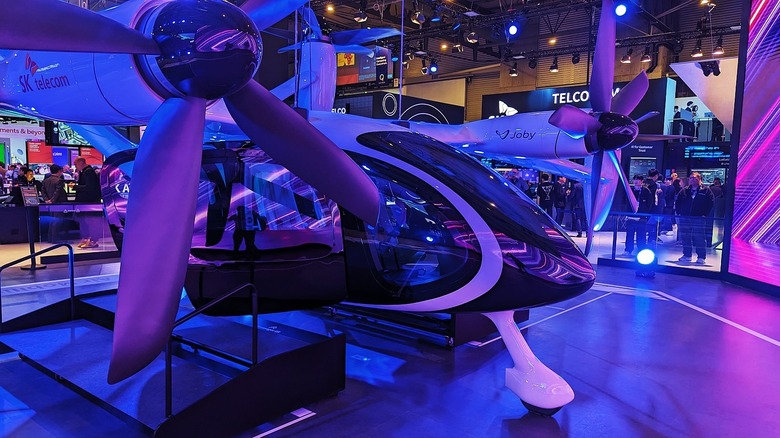
Dave McQuilling/SlashGear
It’s day two of MWC 2024, and there’s still no shortage of exciting things to see and experience on the show floor. Today’s picks include a couple of ways to take to the air, more onboard AI for laptop users, a taste of something different, and absolutely Nothing at all. I did manage to get hands-on with a couple of the exhibits. This included a simulated air taxi flight and a swig of water laced with hopefully harmless — but still intentionally unpleasant-tasting — chemicals.
Beyond that, I tested a couple of AI features on some of Dell’s new laptops, which seem less dangerous than chemicals and air travel, though you can never be sure. While today involved ticking off some of the more stand-out booths and companies, there’s also plenty more coming up over the next couple of days. Until then, here’s a more detailed look at what the SlashGear contingent got up to on a pleasantly sunny Tuesday in Barcelona.
A potential flying car
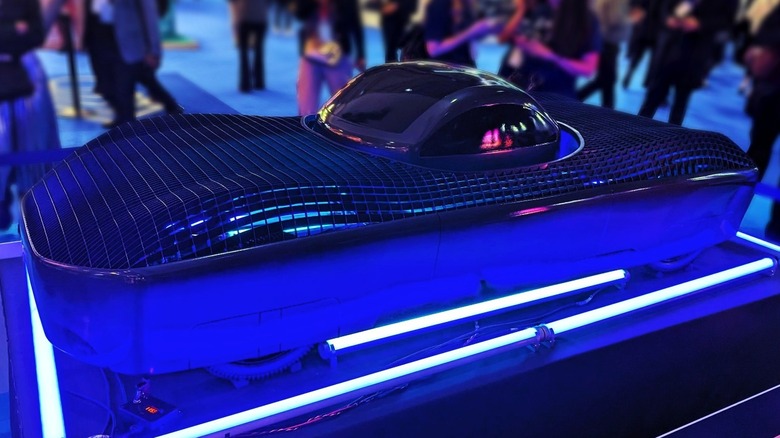
Dave McQuilling/SlashGear
If you’ve ever been stuck in traffic and wished you could fly away from it all, you may get your chance. Alef, a company with a promising-looking flying car prototype, is present at MWC with a scaled-down model of its final product. The vehicle, which is fully electric, uses a set of propellers to take off from the ground. If you’re flying long distances, the cabin holding the driver can also tilt — ensuring you stay level while the rest of the vehicle does its thing.
Production is set to begin at the end of 2025, the same year that will mark Alef’s 10th anniversary. Initially, you’ll need a driver’s license for any road-based vehicle use, and a pilot’s license if you want to take to the air. Alef is hopeful that this will eventually change. With no full-sized prototype version of the car currently in existence, it is possible to be a little pessimistic about the whole thing. Still, if you’re in the optimist camp, pre-orders for Alef’s flying four-wheeler start at $150.
An actual air taxi
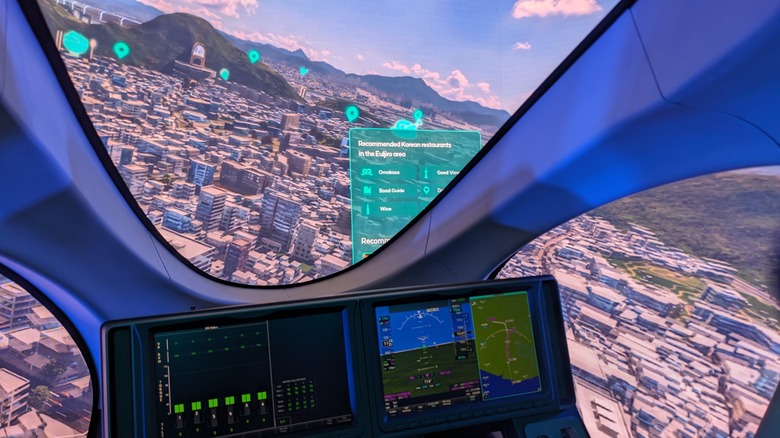
Dave McQuilling/SlashGear
If you still want to fly over any troublesome traffic, but don’t want to take the controls yourself, then there are still options. One of them is SK Telecom’s air taxi, which is absolutely impossible to miss in Hall 3. The aircraft can be hoisted up on cables for a demonstration ride, and a video projected onto a large screen will fool your eyes into thinking you’re flying over a South Korean city. Several AI features also made an appearance during the demo ride, including the ability to identify landmarks. The «AI» also acted as both pilot and narrator on the trip.
Unlike some flying concepts, SK Telecom’s effort may not be far off. The cell company wants to have a flying taxi service operating in South Korea by the end of 2025. The aircraft itself is the result of a partnership with Joby, the company behind a similar air taxi service in New York. There is currently a difference between the simulated versions and the real one. Due to legislation, air taxis currently have to be operated by a human pilot. So, while you can fly through one of the world’s biggest cities on Joby’s craft, an AI air chauffeur may still be a long way away.
Dell’s dedicated AI chip
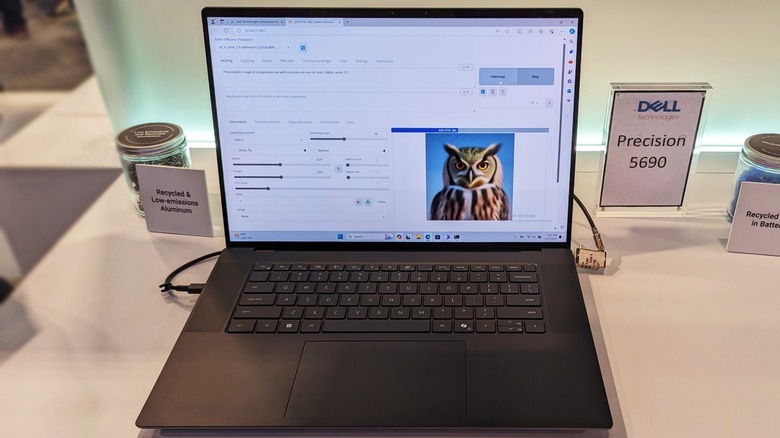
Dave McQuilling/SlashGear
Dell’s latest line of Latitude laptops come with a new chip. Alongside the traditional GPU and CPU is a Neural Processing Unit (NPU). It’s basically a specialist bit of silicon designed to power any AI programs the machine is running. This includes background AI applications designed to make the machine run more efficiently and ensure the device meets the user’s needs. While the chip can be used to give something like Stable Diffusion a boost, that’s just the tip of the iceberg. Dell is releasing a suite of AI features aimed at redefining how we work.
As with many detachable laptops, the new Latitude 7350 Detachable has a heavy business focus. However, the other two laptops may be just what many remote workers are looking for. The NPU chip was created in collaboration with Intel, so there’s a good chance that many devices, Dell and otherwise, will have a similar AI-dedicated chip in the future. If you want to get a glimpse of that future, then check out Dell’s new Latitude line.
A taste of things to come
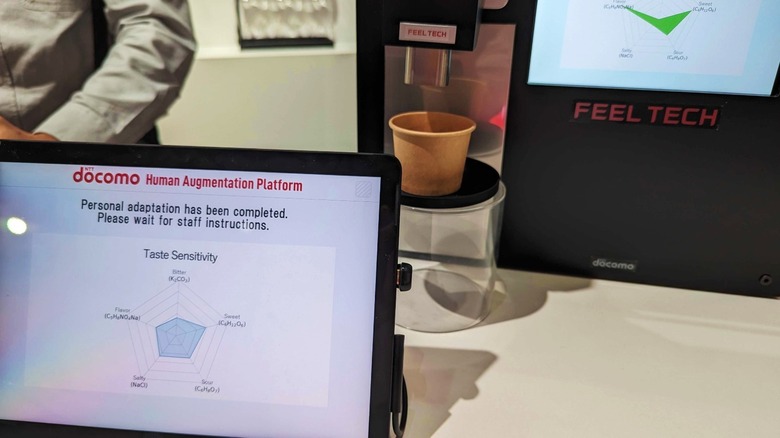
Dave McQuilling/SlashGear
NTT Docomo is one of the companies that is looking beyond 5G connectivity and actively researching 6G technology. But that’s not why it’s in this roundup. I found myself at the back of the Japanese phone operator’s booth, knocking back shots of chemical-laced water. NTT Docomo’s Feel Tech Bar offers a way to taste things from another person’s perspective (not to be confused with the machine that lets you lick a custom flavor off the screen). In this particular demo, the experience involved tomato soup on the palate of a young child.
After filling out a short survey, NTT Docomo’s software worked out how my tongue responded to various flavors and mixed up something that would taste as overly salty and bitter to me as that hypothetical soup would taste to a hypothetical kid. In terms of practical applications, just as the demo suggested, NTT Docomo believes you may be able to have a child, friend, or other individual try your cooking remotely. The company says its tech could also be used by people who want to sample a dish from an app like Uber Eats before putting in an order. Both of those scenarios seem a long way off, but the demo was certainly an interesting distraction.
Nothing to see here
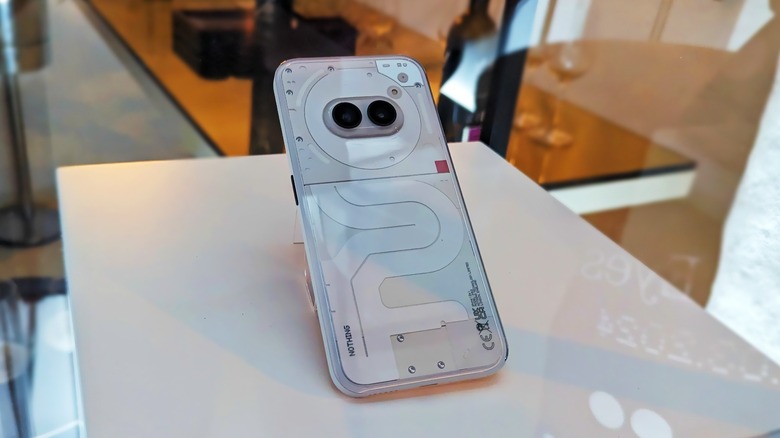
Dave McQuilling/SlashGear
So, what can you say about one of the most hyped phone unveilings of MWC 2024? Nothing. Or very little, at least. The real beefy details won’t be released until next month, but we do finally know what the highly anticipated budget device looks like. Amid a large crowd of people, some trays of sushi, and a few questionable decor choices, the Nothing Phone 2a made its first official appearance. Its white coloring, patterning, lights, and camera placement are initially Star Wars droid-esque — though you do see some interesting touches when you look closer.
The pattern on the placement looks like a big number two, and the blinking lights ringing the camera give the device a loud and unique look. Of course, looks aren’t everything, and it’s next month’s announcement of the device’s specs and features that will ultimately decide whether or not the Nothing Phone 2a is a worthy option or a waste of money.